Bidar Air Force Station
Air Force Station, Bidar is one of the Premier Flying Training establishments of the Indian Air Force. It was established during World War II, has been a training centre for budding pilots of the IAF since 1963. The air base had trainer aircraft like HT2 and various variants of Kiran aircraft for nearly four decades.[1] Now it has been remodelled and refurbished for the arrival of the Hawks. The runway has been extended to 9,000 feet and new facilities for aircraft and engine maintenance and testing are built.[2]
| Bidar Air Force Station | |
|---|---|
| Disbanded | 52 Squadron (The Sharks) aka Surya Kiran Aerobatic Team on 30 June 2011 |
| Country | |
| Branch | |
| Type | Flying Training Establishment |
| Role | Intermediate Jet Fighter Training (Kiran) and Advanced Jet Fighter Training (Hawk) - Flying, Ground and Technical |
| Part of | Training Command |
| Garrison/HQ | AF Stn Bidar |
| Colors | Navy blue, sky blue & white |
| Equipment | Fighter Aircraft |
| Aircraft flown | |
| Trainer | Hawk Mk 132 since November 2007, Kiran MkII till July 2012 |

It is home for the second biggest training centre in the country. Graduates from the Air Force Academy come here to learn the skills and techniques to become a next generation fighter pilot before being assigned to one of the combat units of the world's fourth-largest air force.[2] Around 60-90 sorties per day are flown from the base thereby generating the highest amount of single-engine flying hours in the country from this air base.
Once the home base for 52nd Squadron, the station now houses the three Hawk Operational Training Squadrons (HOTS-A Aggressors, HOTS-B Bravehearts and HOTS-C Cheetahs). In addition the Weapon System Operators' School also functions here. A fourth Squadron is ready to be raised shortly.[3] In a phased manner, 66 Hawk aircraft are to be added to the AFS Bidar.
Location
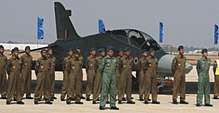
Bidar is located in Karnataka, India, away from the bigger hubs and is excellent for airspace and weather. Being located on the Deccan Plateau provides protection from the tropical conditions that are experienced on the coast. Flying conditions are invariably good all year round and the climate is relatively mild – except from mid-March to mid-May – so the training base don't lose many sorties to bad weather which is important as the trainees aren't instrument rated so they cannot fly in poor conditions.[2]
Surya Kiran Aerobatic Team
The Suryakiran Aerobatic Team (SKAT) flew its first 6 aircraft formation sortie on 27 May 96 at AFS Bidar. Unlike most teams, which fly either frontline fighter aircraft or advanced jet trainers, SKAT flies an indigenous basic jet trainer, the Kiran MK II. The team was suspended in February 2011 and was re-established with Hawk Mk-132 aircraft in 2017.[4]
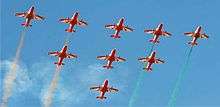
Overview
The Station was also the home of the Surya Kiran Aerobatic Team. The team was a true ambassador of IAF. However, after their dazzling display during Aero India 2011, to meet its increasing training requirements, the IAF took decision to disband the team on 30 June 2011.[3]
History
Aerobatic Team is associated with Bidar AFS since 1990 with arrival of four-aircraft team called the Formation Aerobatic Team from Thunderbolt which were set up on Kiran trainers. The SKAT was born in 1996 and developed over time. It was conferred with Squadron status in 2006.
Training
Pilots serving as Qualified Flying Instructors (QFIs) with approximately 1000 hours of experience on fighter aircraft can volunteer to be a part of the SKAT. Volunteers are invited to fly with the team, where their performance and personality traits are evaluated. Over the next six months or so, selected pilots then fly 70-75 sorties practising various manoeuvres before they get into the formation flying team.
The average tenure of a SKAT pilot is about three years. Two new pilots join the team every six months. Starting at high altitude with a single aircraft sortie, with the team leader or the deputy team leader in the Kiran's left-hand seat, the trainee moves on to two-aircraft and then three-aircraft formation flying. After mastering the skill of flying with two aircraft on either side, the trainee then goes in for four-aircraft and six-aircraft sorties before finally graduating on to nine-aircraft sorties. All types of rolls, loops, dives and formations are flown at various training stages.[5]
Composition
The team is led by a Commanding Officer who is also the leader of the formation during display sorties. The squad has 13 pilots out of whom nine perform at any given time. These display aircraft have enthralled audiences with their manoeuvres, since their inception in 1996. Senior and experienced fighter pilots are chosen to be part of the prestigious SKAT, which used the IAF's basic HJT-16 Kiran Mk-2 trainer aircraft. It now uses the Hawk Mk-132 aircraft since 2017.[4][6]
Formations and Manoeuvres
To perform the manoeuvres, a pilot requires tremendous concentration, grit and determination to take the aircraft to the extremes of its envelope.
- The most popular and also the most dangerous formation of the SKAT has been of the nine aircraft taking off in a V-shaped formation of three and joining up in close formation, manoeuvring between speeds of 150 and 650 km per hour with their wing tips a mere 5 metres apart.[7]
- Six Kiran trainer jets streak barely 50 metres above the ground in an arrowhead formation. With their wingtips separated by just five metres, they move into a diamond formation and roll towards their left to form a "card" formation with three aircraft flying abreast and another three trailing just behind.
- Reforming again after "synchro head-on cross", where two aircraft on the same level cross each other at a relative speed of 1100 km/h with a separation of just five metres, the brightly painted red and white aircraft, with their exhausts trailing smoke, dive vertically and then pull up again in different directions to simulate a bomb burst.
Kiran Mk II
In July, 2012, the final Kiran Mk II aircraft flew out of Bidar to Tambaram. This aircraft was in Bidar for almost three decades.[3]
Hawk Mk 132
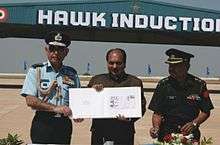
Overview
Flying training at AFS Bidar is now done on the Hawk Mk 132 aircraft. With the arrival of enhanced number of trainees and full complement of Hawk aircraft, the training academy is abuzz with activity. The station roars with engine noises throughout the day. The Hawk brings a huge step-up in capability as a training aircraft, bridging the gap between the basic piston-engined trainer and the high performance flying of an advanced fighter aircraft. It is aerodynamically much more forgiving and is a great introduction for trainee pilots to familiarise on before they go into fighters.[2]
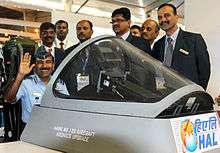
The stage-III training, ahead of the pilots graduating to the supersonic jets such as MiG-21s, Jaguars, Mirages and Sukhoi SU-30MKIs. is carried out as the Station is the mother base for Hawk Mk 132 aircraft. Modern servicing facilities have been created which bench-mark the maintenance philosophy of IAF. The average airmen earlier worked with basic tools for servicing the aircraft. He has now become tech savvy in tune with the requirements of modern aircraft.[3]
The Hawk Mk 132 is a variant of the highly successful BAE Systems. It incorporates an open architecture mission computer, glass cockpit and a state of the art avionics suite including a new generation Inertial Navigation System with GPS (INGPS). It is also equipped with several Indian made components such as the communication sets, Identification Friend or Foe (IFF) system and the radio altimeter. In addition to being an advanced jet trainer, Hawk Mk 132 is fully combat capable and can carry air to air missile and air to ground armament. It could also be used as a lightweight fighter.[8] Hawk can also be flown at night and perform a wide range of aerobatic manoeuvres.
History
The need for an AJT was first articulated by the IAF in 1982 and ever since has remained high on IAF's agenda for procurement. The IAF felt that there existed a quantum difference in the skill and judgement levels required of a young fighter pilot as he transited to state of the art fighters such as the Su-30 MKI, Mirage 2000 and MiG-29. The Hawk 132 would adequately serve as lead in trainer for these advanced aircraft.[8]

Two Hawk Mk 132 advanced jet trainer (AJT) aircraft that departed BAE Systems', Warton airfield in UK on 8 November 2007, reached Air Force Station Bidar on 12 November 2007. The Hawk pair flown by a mix crew of BAE Systems and IAF pilots, Wing Commander Pankaj Jain and Squadron Leader Tarun Hindwani, first landed in India at the Jamnagar airbase while ferrying from Muscat, their previous stopover, on their way to Bidar. The AJT pair was escorted into Bidar airspace by the Suryakirans streaming national colours. Air Marshal GS Chaudhry, Air Officer Commanding-in-Chief, Training Command and Air Commodore Ramesh Rai, AOC, AFS Bidar, oversaw the first arrival of the aircraft. This heralded yet another saga towards meeting the training requirements of the IAF pilots.[9]
Of the 66 aircraft being purchased, 24 were developed, built and supplied by BAE Systems, UK; while Hindustan Aeronautics Limited (HAL), Bengaluru is to manufacture the remaining 42 aircraft under licence in India.[9]
Bidar airfield, located in the North West of Karnataka, approx 150 km from Hyderabad, was chosen as the main operating base for the Hawk. This base has been a training establishment for budding fighter pilots of the IAF since 1963. To ensure the smooth induction of the Hawk, the Air Warriors under the command of Air Commodore Ramesh Rai have worked tirelessly to put the required infrastructure in place. They were, at all stages, assisted by the local civil authorities and population. The work services included extension of the two runways, improvement in landing facilities and creation of servicing facilities for the technology intensive Hawk aircraft.[8]
Training
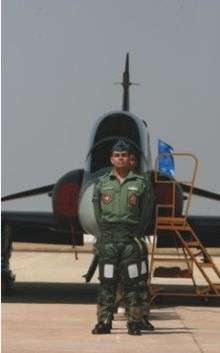
Bidar base has a classroom and fully computer-aided learning system for instruction of pilots and maintenance personnel.[2]

Significance
The induction of Hawk aircraft in the IAF has not only brought in a modern trainer into the IAF, but an entire Hawk culture. This culture focuses on honesty, discipline in air and ground and steadfast adherence to SOPs. The modern training philosophy is in tune with the IAF watch word “People First Mission Always”. At the end of the one-year training, the Station produces a fine fighter pilot, a humane gentleman and an honest officer. For its excellence in all spheres, especially in training of pilots, the Station was adjudged as the Best Flying Training Establishment in 2011 and 2014. The Station is also the proud winner of many other trophies for excellence in various other activities.
The Station and the Air Force is looking forward to the formation of a new aerobatic team with Hawk Mk 132 aircraft. Efforts for this are in progress at Air HQ. Before the team is formed, the Station aims to improve its infrastructure to train many more IAF and Indian Navy pilots. The Station also aims to provide best professionals to the Operational Squadrons. This will bring in the Hawk culture of dedication, discipline and honesty in its truest sense all over the Air Force.
Accidents
- On 18 March 2006, Wing Commander Dheeraj Bhatia and Squadron Leader Shailendra Singh lost their lives while flying the Kiran aircraft. This was the first-ever crash involving a Surya Kiran team. It seems neither man nor machine was at fault. Aerobatics is a risky business. The reaction time is a fraction of a second. In all probability, therefore, it was an accident - This was how senior IAF officials described the crash.[10] However, later, the cause of accident was established as human error (aircrew).A continuous and multi-faceted effort is always underway in the IAF to enhance and upgrade flight safety.[11]
- A Kiran aircraft of the Indian Air Force (IAF) crashed near Air Force Station, Bidar on 21 January 2009 kiling Wing Commander Daliwal.[12] The incident occurred during a routine practice session by IAF's aerobatics team. This was the second fatal Surya Kiran air mishap.[13]
Distinguished Officers
- Flight Lieutenant Rajika Sharma of the Station was the first Women Officer to scale the mighty Mt Everest. She was a met officer posted to the Station when she achieved this distinction.[3]
- The team comprising Squadron Leader R Raman and Flt Lt Rohan Anand, both of this Station, were the proud runners-up of IAF Squash Championship in 2011-12 and 2012-13.[3]
- A number of sportsmen took part in the inter-command championships and brought laurels to the Station and to Training Command.[3]
- Air Marshal Ramesh Rai has commanded theAir Force Station, Bidar and Advance HQ at Kolkata. The HAWK advanced Jet Trainers (AJT) were inducted during his tenure at Air Force Station Bidar wherein he pioneered the training system on the AJT. He served as of Central Air Command before taking over as AOC-in-C, Training Command.[14]
- Air Marshal Paramjit Singh Gill AVSM VM, Senior Air Staff Officer (SASO) of WAC, was Chief Instructor (CI) at Air Force Stn Bidar[15]
- Air Marshal VR Iyer, Air Officer in charge Personnel at Air HQ being a qualified flying instructor, he has imparted training at Air Force Station Bidar.[16]
- Chief of the Air Staff, Air Chief Marshal PV Naik VSM ADC, had commanded the AFS Bidar.[17]
Galleries
- Hawk flying over AFS Bidar
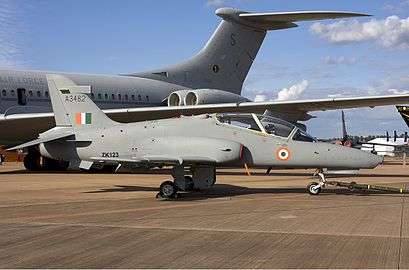 Indian Air Force BAE Systems Hawk 132 Lofting-1
Indian Air Force BAE Systems Hawk 132 Lofting-1
References
- "Grand reception for Hawk aircraft in Bidar". The Hindu. 12 November 2007. Retrieved 7 March 2015.
- "Hawk soars over Bidar". India Strategic. November 2011. Retrieved 14 February 2012.
- Magazine, Sainik Samachar (1 October 2012). AFS Bidar, Pilots' Cradle. Director General (Media & Communications) Directorate of Public Relations, South Block, New Delhi-110 011.
- Surya Kiran
- "AEROBATICS Flying colours of courage". The Tribune. 31 March 2007.
- "Air Force Dare Devils to Fly Again After 4 Years". NDTV. 16 February 2015.
- "Aerobatic team Surya Kiran set to fly into sunset". DNA India. 4 February 2011.
- "ADVANCED JET TRAINER HAWK-132 TO BE INDUCTED INTO INDIAN AIR FORCE ON 23 FEB 08". Government Of India (Ministry of Defence). Press Information Bureau. 11 February 2008.
- "AF Hawks reach Bidar, touch base at Jamnagar on their stopover from UK". Government Of India. Press Information Bureau (Ministry of Defence). 12 November 2007.
- "Surya Kiran aircraft crashes in Bidar". The Hindu. 19 March 2006. Retrieved 28 October 2018.
- "IAF AIRCRAFT CRASH". Government Of India (Ministry of Defence). Press Information Bureau. 17 May 2006.
- "IAF pilot killed in Surya Kiran crash". Rediff.com. 21 January 2009. Retrieved 9 March 2015.
- "Rising Air Crashes in IAF". Ministry of Defence (Government of India). Press Information Bureau. 25 February 2005.
- "Air Marshal Ramesh Rai takes over as Air officer Commanding-in-Chief of Training Command, IAF". Government of India (Ministry of Defence). Press Information Bureau. 1 July 2014.
- "Air Marshal Paramjit Singh Gill AVSM VM Assumes Appointment of SASO, WAC". Government of India (Ministry of Defence). Press Information Bureau. 8 June 2012.
- "Air Vice Marshal VR Iyer to take over as Air Officer in charge personnel at Air HQ on Promotion". Ministry of Defence (Government of India). Press Information Bureau. 31 January 2007.
- "AIR MARSHAL PV NAIK IS THE NEW VICE CHIEF OF AIR STAFF". Ministry of Defence, Government of India. Press Information Bureau. 1 January 2008.
| Wikimedia Commons has media related to Bidar Air Force Station. |